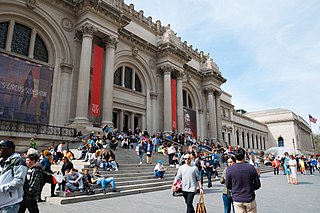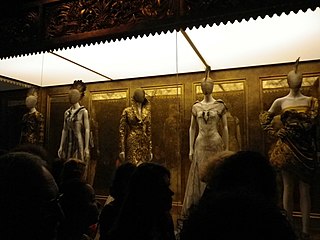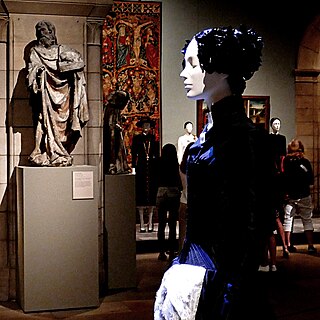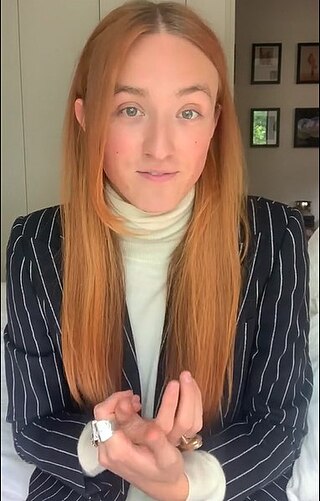Camp is an aesthetic style and sensibility that regards something as appealing because of its bad taste and ironic value. Camp aesthetics disrupt many of modernism's notions of what art is and what can be classified as high art by inverting aesthetic attributes such as beauty, value, and taste through an invitation of a different kind of apprehension and consumption.

"Notes on 'Camp'" is a 1964 essay by Susan Sontag that brought the aesthetic sensibility known as "camp" to mainstream consciousness.

Moschino is an Italian luxury fashion house founded in 1983 by Franco Moschino in Milan known for over-the-top, campy designs. The company specializes in ready-to-wear, handbags, and fashion accessories. Moschino's creative director is Adrian Appiolaza.

The Met Gala, formally called the Costume Institute Benefit, is an annual fundraising Festival/gala held for the benefit of the Metropolitan Museum of Art's Costume Institute in Manhattan. The Met Gala is popularly regarded as the world's most prestigious and glamorous fashion event. Fashion stars and models are able to express themselves by their fit according to the theme and social gathering and is known as "fashion's biggest night"; an invitation is highly sought after. Personalities who are perceived to be culturally relevant to contemporary society amongst various professional spheres, including fashion, film, television, music, theater, business, sports, social media, and politics, are invited to attend the Met Gala, organized by the fashion magazine Vogue. The entry price for one ticket has risen to US$75,000 in 2024, an increase from $50,000 in 2023, to attend the annual gala in the world's principal financial center and fashion capital, New York City.

Alexander McQueen: Savage Beauty was an art exhibition held in 2011 at the Metropolitan Museum of Art featuring clothing created by British fashion designer Alexander McQueen, as well as accessories created for his runway shows. The exhibit was extremely popular in New York City and resulted in what was then record attendance for the museum. The curators were Andrew Bolton and Harold Koda.

PUNK: Chaos to Couture is a 2013 non-fiction book by Andrew Bolton, with an introduction by Andrew Bolton, an introduction by Jon Savage, and prefaces by Richard Hell and John Lydon, the "catalog of the exhibition held at the Metropolitan Museum of Art, New York, May 9 - August 14, 2013'.

The Anna Wintour Costume Center is a wing of the Metropolitan Museum of Art main building in Manhattan that houses the collection of the Costume Institute, a curatorial department of the museum focused on fashion and costume design. The center is named after Anna Wintour, the longtime editor-in-chief of Vogue, Chief Content Officer of Condé Nast, and chair of the museum's annual Met Gala since 1995. It was endowed by Lizzie and Jonathan Tisch. As of August 2017, the chief curator is Andrew Bolton.
Andrew John Bolton is a British museum curator and current head curator of the Anna Wintour Costume Center at the Metropolitan Museum of Art in New York City.

The First Monday in May is a 2016 documentary film directed by Andrew Rossi. The film follows the creation of the Metropolitan Museum of Art's most attended fashion exhibit in history: the 2015 art exhibition China: Through the Looking Glass by curator Andrew Bolton at New York's Metropolitan Museum of Art.
Harold Koda is an American fashion scholar, curator, and the former curator-in-chief of the Anna Wintour Costume Center at the Metropolitan Museum of Art.

Rei Kawakubo/Comme des Garçons Art of the In-Between was an art exhibition about the work of fashion designer Rei Kawakubo and her designs for her fashion house, Comme des Garçons. The exhibition ran from May 4 to September 4, 2017, at the Metropolitan Museum of Art. It was curated by Andrew Bolton, who worked closely with Kawakubo to select works for the exhibition. On display were 140 women's costumes spanning the entirety of her career until 2017. This exhibit represents Kawakubo in an immersive world of Gesamtkunstwerk, "total work of art".
Jacqueline Kennedy: The White House Years was a 2001 exhibition that was presented by the Costume Institute at the Metropolitan Museum of Art. The event was timed to mark the 40th anniversary of her "emergence as America’s first lady." Organized by The Metropolitan Museum of Art and the John F. Kennedy Library and Museum, the exhibition was devoted to exploring the former First Lady's iconic style and impact on the fashion world.
Superheroes: Fashion and Fantasy was an art exhibition held 7 May - 1 September 2008 at the Metropolitan Museum of Art featuring clothing inspired by superhero costuming, along with actual costumes from superhero films. Sponsored by Giorgio Armani, the exhibit was curated by Andrew Bolton of the Costume Center, and author Michael Chabon wrote material for the exhibition catalog. Backdrops for the exhibition were derived from Alex Ross's Justice, Jamie Rama, Nathan Crowley, Dermot Power, Gary Frank, and photographs of Thomas Jane as The Punisher, Nicolas Cage as Ghost Rider, and Michelle Pfeiffer as Catwoman.
The Model as Muse: Embodying Fashion was a fashion exhibition at the Metropolitan Museum of Art that ran from May 6 to August 9, 2009. It focused on iconic fashion models of the twentieth century who inspired fashion in their respective eras. Organized by historical period from 1947 to 1997, the exhibition was made possible by Marc Jacobs with additional funding from Condé Nast. It was curated by Harold Koda and Kohle Yohannan.
American Woman: Fashioning a National Identity was an exhibit at the Metropolitan Museum of Art in New York City, New York that ran from May 5 to August 15, 2010. This exhibition explored the evolution of the modern woman's image from the 1890s to the 1940s in the United States. Taking approximately nine months to complete, the goal of the exhibition was to create a "time machine" of women's clothing from the past to present. The exhibit was the first from the Costume Institute to incorporate pieces from the Brooklyn Museum Costume collection which had recently been transferred to the Met's holdings. The exhibition, consisting of a range of women's clothing from ball gowns to cycling suits, displayed the impact of "Gibson Girls", "Screen Sirens", and "Bohemians" on American women.

Romance Was Born is an Australian fashion house, founded by Anna Plunkett and Luke Sales in 2005. Producing haute couture and women's ready-to-wear garments and accessories, the brand produces designs that "freely toy with the relationship between fashion and art", often evoking an influence of Australiana.

Heavenly Bodies: Fashion and the Catholic Imagination was the 2018 high fashion art exhibition of the Anna Wintour Costume Center, a wing of The Metropolitan Museum of Art (MMA) which houses the collection of the Costume Institute.

Harris Reed is a British-American fashion designer and creative director for French fashion house Nina Ricci. He is the son of the Oscar-winning, British documentary film producer Nicholas Reed and the American model and candlemaker Lynette Reed.
In America: An Anthology of Fashion is the 2022 high fashion art exhibition of the Anna Wintour Costume Center, a wing of the Metropolitan Museum of Art (MMA) which houses the collection of the Costume Institute. It is the piece of a two-part exhibit that explores fashion in the United States. This exhibit highlights stylistic narratives and histories of the American Wing Period. Each immersive period rooms reflect America from the 1700s to the 1970s and captures men's and women's fashion. The rooms also display America's domestic life and the influences of cultures, politics, and style at each period.
Sleeping Beauties: Reawakening Fashion is the 2024 high fashion art exhibition of the Anna Wintour Costume Center, a wing of the Metropolitan Museum of Art (MMA) which houses the collection of the Costume Institute. The exhibition was announced on November 8, 2023. The exhibition was held at the museum from May 10 to September 2, 2024. It featured approximately 250 items from the permanent collection of the Costume Institute that were displayed using AI and CGI with themes of sea, land, and sky as a metaphor for the fragility and ephemerality of fashion and a vehicle to examine the cyclical themes of rebirth and renewal.




















